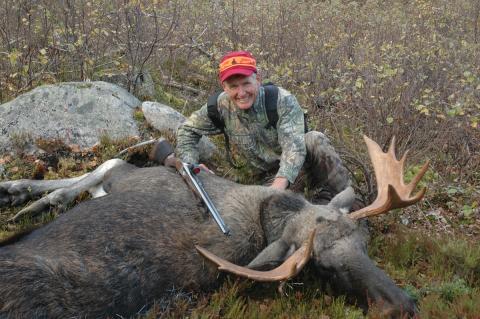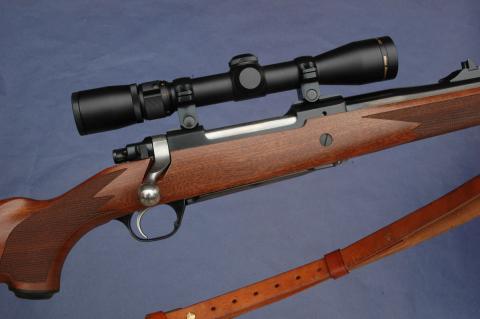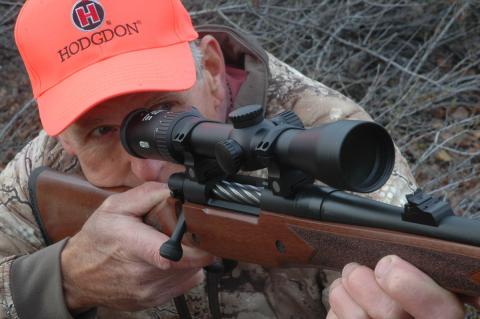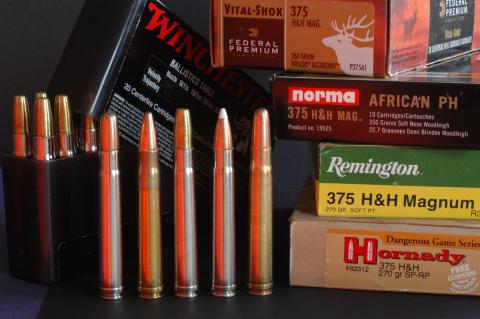You can’t replicate the age and field record of the .375 H&H. But improve upon it?
When my first softpoint struck, the hunt was over. But in true buffalo fashion, the kill was just starting. Useless shoulder hardly slowing his pace, the bull galloped closer. A solid drove through to the bone on the off-side, mincing more lung. The animal stumbled, then skidded, dead in billowing dust.
Holland & Holland announced the .375 Belted Rimless Nitro Express in 1912. It came stateside courtesy Western Cartridge Company 13 years later when WCC also began loading a .30-caliber version. The .300 H&H Magnum, or Super .30, saw more action in North America than did its parent. But Griffin & Howe built many lovely rifles on Magnum Mauser actions in .375 H&H. Safari-bound hunters found it much more pleasant to fire in bolt rifles than the .416 Rigby. It shot about as flat as a .30-’06 and downed Africa’s biggest game with surprising efficiency.
Seasoned hunters such as John “Pondoro” Taylor and Jack O’Connor wrote glowingly about the .375. Once, observing an elephant cull, I saw a 300-grain .375 solid drop an elephant quartering away. Later, the rifleman told me he favored his rifle over government-issued .458s because his bullets drove deeper, “…and the .375 doesn’t kick you out of your socks.”
In 1937, this elegantly tapered cartridge made the charter roster for Winchester’s Model 70. Then, you could buy one for less than $80, but few hunters did. No game on the continent required such power. The .300 Savage was thought stiff enough for elk, the .30-’06 adequate for the biggest bears. Moose fell to Canadian hunters armed with SMLEs in .303 British. Besides, .375 H&H ammo cost more than $2 a box!
Then optics gave hunters sharp aim at greater range. In 1947, Leupold fielded its first riflescope — the Plainsman. Weaver announced the K-series. Faster bullets gained increasing favor.
Beginning in the early 1940s, Roy Weatherby cleverly promoted his wildcat magnums, fashioned from blown-out belted Holland & Holland brass. The .257, .270 and 7mm Weatherby Magnum hulls were finished at 2 1/2 inches to fit standard (.30-’06-length) rifle actions. Roy barreled custom rifles to .375 H&H, but also introduced full-length .300 and .375 cartridges with his signature “venturi” shoulder.
The .375 Weatherby Magnum died young; a fate shared by later .375s. As decades confirmed the .375 H&H as “queen of the medium bores,” challengers were doomed.
Actually, few rounds with .375-diameter bullets matched the muscle of the .375 H&H — 270-grain bullets at 2,700 fps, 300s at 2,550. (The early light-bullet load, a 235-grain softnose at 2,800 fps, fell from grace after disappointing hunters with its steep deceleration and poor penetration.) Weatherby’s .375 sent heavy bullets 200 fps faster, but was not commercially chambered in rifles of other brands.

In the U.S., the earliest smokeless .375 was the .38-55, originally a blackpowder target cartridge. Chambered in 1894 Winchester and 1893 Marlin rifles and the 1899 Savage, it drew a modest following among deer hunters. Handloads for suitable rifles can easily out-perform the traditional factory load of a 255-grain bullet at 1,320 fps. Britain’s .375 Flanged 2 1/2-inch was friskier — its maiden charge of Cordite driving a 270-grain bullet 2,000 fps in 1899 — but it fizzled at market.
More potent was the 9.5×57 Mannlicher-Schoenauer, introduced in 1910 and listed by the Brits as the .375 Nitro-Express Rimless. With 270-grain bullets at 2,150 fps, it’s a ballistic twin to the .400/375 Belted Nitro-Express trotted out about the same time by Holland & Holland. Neither matched the punch of the .369 Nitro-Express, a rimmed cartridge announced by Purdey in 1922. It launched 270-grain bullets at 2,500 fps, roughly 100 fps behind the .375 Flanged Magnum Nitro-Express introduced a decade earlier by Holland & Holland as the rimmed version of its then-new and now enduring belted .375 H&H. I once hunted moose with a .375 Flanged. The load was mild with the kick of a .35 Whelen. The bull fell dead.
The struggles of most .375s to earn their keep surely discouraged cartridge pioneers such as Charles Newton as well as established ammo houses from filling pipelines with new .375 offerings. Also, as the 20th century unspooled, North American hunters drifted to rounds with smaller bores and faster bullets. In Africa and Europe, the likes of the .30-’06 and the 7×57 Mauser became stars. They shot flat, killed well with contemporary softpoints and recoiled with civility.
Surplus infantry rifles in these chamberings were great bargains, and subsequent commercial bolt-actions affordable. For tough game, hunters used the .375 H&H as a baseline cartridge, favoring bigger bores and heavier bullets for buffalo, rhino and elephant. By the time rhino permits had all but vanished, .375 would become the minimum legal bore for such game in parts of Africa. No thinking hunter would opt for a .375 round with less sauce than the belted H&H!
Roy Weatherby may never have shifted his focus from faster, more powerful rounds. In 1953 he announced his .378 Magnum. Unlike the earlier .375Weatherby and kin, this giant cartridge didn’t emerge from brass dating to 1912. Instead of a .532-inch rim and belt, it had a .582-inch rim and .603-inch belt. The hull was 2.908 inches long and .560-inch in diameter at the shoulder. With its 270-grain bullet at a published 3,180 fps, the .378 Weatherby Magnum sent more than three tons of energy out the muzzle. A 300-grain bullet left at 2,825 fps.
The dimensions of this round would put Roy on the hunt for a rifle action big enough to fire it, resulting in the Weatherby Mark V rifle in 1957. The .378 is by common acclaim a punishing cartridge to fire.
In 1978, Winchester probed different territory with its own .375, its hull essentially a beefier and slightly shortened .38-55’s. Firing a 200-grain bullet at 2,200 fps and a 250 at 1,900, it handily upstaged the .30-30 at deer-shooting distances. Winchester chambered it in a new Model 94 Big Bore lever-action, with thicker steel in the rear of the receiver. The .375 Winchester can be fired in .38-55 rifles, but is best kept from early smokeless models and never used in older blackpowder-only chambers. While practical in the whitetail woods and adequate for close-cover elk, this .375 never caught on. It was, in appearance and performance, a pre-Depression cartridge, submerged by a tide of small-bore magnums.
In 2000, the Austrian firm of Steyr surprised the industry with its first cartridge in many decades. Developed in collaboration with Hornady, the .376 Steyr is fashioned from the 7×64 Brenneke case for the Steyr Scout rifle, then just two years old. The .376 comes within 150 fps of .375 H&H performance, in a package that fits standard rifle actions. It can drive 270-grain bullets at 2,600 fps, 300s at 2,400. The path to high-octane rimless rounds had already been probed by Don Allen at Dakota Arms with a series of cartridges on the .404 Jeffery case. His .375 Dakota fired a 270-grain bullet at 2,800 fps, about the same speed as the later (2010) Blaser Magnum on the .404, and Lazzeroni’s 9.53 Saturn — proprietary rounds, all three. Remington’s rimless .375 Ultra Magnum, announced in 2002, launched 270-grain bullets at 2,900 fps, and 300s at 2,760, from a case the same length as the .375 H&H’s, but with greater capacity.

Some hunters wondered amid this stampede of super-.375s about the need for any of them. The old British round killed reliably, fed smoothly, recoiled with less violence and was available in places not yet paved. Its sole failing, if it had one, was its length. With loaded cartridges taping 3.60 inches, the .375 H&H requires a long magazine and bolt. In its youth, Springfields and 1898 Mausers were gunsmithed to accept the cartridge, but such alteration wasn’t cheap. While the 1917 Enfield had a long box and throw, it was a heavy, unattractive action with an abysmal trigger. Again, gunsmithing required.
Winchester’s Model 70 gave the .375 a commercial home. In 1961 and ’62, Remington’s Custom Shop listed a Kodiak Model 725 in .375, but calls for a standard-length, equally powerful .375 increased.
In 2006, Ruger and Hornady introduced the .375 Ruger with a 2.58-inch case and the Holland’s .532-inch rim, but it had no belt, headspacing instead on a 30-degree shoulder — a fetching design. In 24-inch test barrels, the .375 Ruger sent 270-grain bullets at 2,840 fps and 300s at 2,660, trumping the .375 H&H by more than 100 fps.
I quickly scrounged Kimber and Ruger rifles in the new chambering. They cycled without a hitch and shot accurately. Recoil seemed a bit sharper than from .375 H&H rifles, but the bullets were moving a bit faster. Also, recoil depends on stock design and rifle weight as well as on ballistic muscle.
I bought the Ruger’s progeny, a Hawkeye African. It’s a lovely rifle, listing for just under a grand. While it has yet to pile up big game, its accuracy, reliability and handling qualities certainly qualify it for dangerous game. Of course, once a bullet exits the muzzle, the rifle’s relevance diminishes. Whether fired in 1912 or 2017, from a Rigby or a Ruger, from a long, tapered case or a shorter, arguably more efficient one, a .375 bullet of given weight at given speed cuts a predictable arc to land with predictable authority.
My most recent dalliance with the .375 Ruger started when Mossberg listed it as a charter round in its Patriot series of bolt rifles. Evidently, demand outstripped initial supply as my request for a blued, walnut-stocked version wasn’t filled for months, but the rifle was worth the wait. Selling for about $400, it’s one of the most affordable .375s of any kind, but it doesn’t look or feel cheap.

The plain walnut has clean, classic lines. Stippled panels fore and aft replace checkering. They’re neatly cut. Two reinforcing pins bracketing the magazine well are reserved for the .375; other Patriots have only one, in front. Most also have fluted barrels with no sights, while the .375’s is smooth with a Williams open rear sight and a fiber-optic front on a short ramp. All barrels are 22-inches long, with recessed crowns. They’re free-floated.
At 7 1/4 pounds, this Mossberg is a lightweight .375! While the sculpted cheekpiece, straight comb and ventilated recoil pad tame the kick of this frisky round, you’ll know without doubt that the rifle fired. (Three other Patriots in .375 Ruger, with laminated and synthetic stocks and Marincote as well as blued metal, scale from 6 1/2 to 7 1/2 pounds.) The LBA, or Lightning Bolt Action, trigger on my rifle breaks at a pleasingly light 2 1/4 pounds. Its integral tab must be depressed to fire, so whatever the break weight, a blow won’t jar the rifle to discharge.
Mossberg Patriots have detachable box magazines of lightweight polymer. Mine has a little play when seated but doesn’t rattle when I shake the rifle. The release tab is recessed up front. The follower feeds a twin-lug, spiral-fluted bolt that pushes each round into the chamber before the bolt-face claw engages. Extraction and ejection are positive.
Impressed with the features and function of the Patriot, I also liked its agility and balance and the way the stock aligned my eye quickly with the iron sights. It deserved a good scope for accuracy trials. So I installed a brilliant Meopta R2, a 1.7-10x42mm most hunters would reserve for a more costly rifle. It proved a perfect match for this .375 Ruger, both aesthetically and at the range. Perhaps I could have fired a group as small with other optics…. Three shots in one ragged hole is a coup with any rifle, let alone a modestly priced lightweight chambered to a dangerous-game cartridge! It wasn’t a fluke, as subsequent walnut-size groups proved.
Cartridge design gets some credit. My Hawkeye African in .375 Ruger has also fired snug groups. Some rounds seem inherently accurate, albeit demonstrating this is more difficult than declaring it. To be fair, a .375 H&H shot the smallest knot I’ve fired with a hunting rifle to date. Maybe both these medium-bores want to shoot well! Then too, Hornady’s 270-grain factory loads deserve a nod. So far, .375 Ruger ammo comes only from Hornady and, more recently, from Swift.
Lord willing, I’ll soon have a chance to carry both Ruger and Mossberg rifles on big game trails. I expect they’ll match the performance of Winchester, Montana and Holland & Holland rifles in .375 H&H that have given me animals as small as bushbuck, as big as elephant. Maybe it’s time that 1912 cartridge shared the field with the .375 Ruger, surely the best of runners-up. –Wayne Van Zwoll

